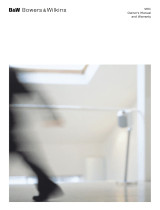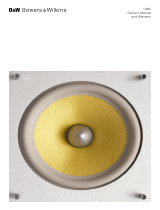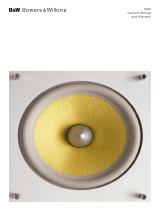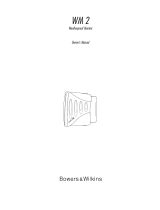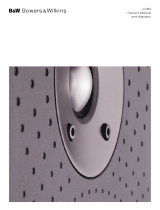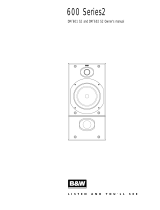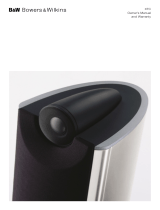Page is loading ...

Custom Installation
CDS3
Owner’s Manual

&IGURE
&IGURE
&IGURE
&IGURE
SPEAKERS OUT
Amplifier
L
R
#$3-OUNTING4EMPLATE
&IGURE
&IGURE
&IGURE
o
o
CM
FT
o
o
#$3
3ERIAL.O
7
"7'ROUP,TD
-ADEIN%NGLAND
&ABRIQUÏEN!NGLETERRE
#$3
3ERIAL.O
7
"7'ROUP,TD
-ADEIN%NGLAND
&ABRIQUÏEN!NGLETERRE
&IGURE
rCM
&IGURE
&IGURE
&IGURE
&IGUREA
&IGUREB

Contents
English
Owner’s Manual............2
Limited Warranty...........3
Français
Manuel d’utilisation.......4
Garantie limitée.............6
Deutsch
Bedienungsanleitung.....7
Garantie .......................9
Español
Manual de
instrucciones ..............10
Garantía limitada.........12
Português
Manual do utilizador....13
Garantia limitada.........15
Italiano
Manuale di istruzioni ...16
Garanzia limitata .........18
Nederlands
Handleiding ................19
Garantie .....................21
Ελληνικά
Ãδηγίες Ìρήσεως ....22
Περιïρισµένη
εγγύηση....................25
Русский
Руководство по
эксплуатации ............26
Ограниченная
гарантия....................28
"esky
Návod k pouãití..........29
Záruka .......................30
Magyar
Használati útmutató ...31
Korlátozott garancia ..33
Polski
Instrukcja
uÃytkownika ...............34
Gwarancja .................36
.....................37
.......................39
.......................40
.......................41
EU Declaration of
Conformity..................43
Technical
Specifications .............44
6002 CDS3 OM Inner Iss1 22/3/07 3:52 pm Page 1

English
Owner’s manual
Dear customer,
Thank you for choosing Bowers & Wilkins.
We are confident that you will enjoy many years of
l
istening pleasure from your speakers, but please read
this manual fully before installing them. It will help you
optimise their performance.
B&W maintains a network of dedicated distributors in
over 60 countries who will be able to help you should
you have any problems your dealer cannot resolve.
Environmental Information
All B&W products are designed to
comply with international directives on
the Restriction of Hazardous
Substances (RoHS) in electrical and electronic
equipment and the disposal of Waste Electrical and
Electronic Equipment (WEEE). These symbols indicate
compliance and that the products must be
appropriately recycled or processed in accordance
with these directives. Consult your local waste
disposal authority for guidance.
Unpacking (figure 1)
• Fold the carton flaps right back and invert the
carton and contents.
• Lift the carton clear of the contents and remove
the inner packaging from the speakers.
We suggest you retain the packing for future use.
Operation
The CDS3 is specifically designed as an in-wall
surround speaker for multi-channel audio and home
theatre installations.
Surround speakers generally fall into two main types –
those that one might describe as 'normal' speakers –
so-called monopoles, where the sound comes from a
set of drive units mounted on the front of the
enclosure – and those that give a more diffuse sound
field, such as dipoles. Each type has its advantages.
Most multi-channel music is recorded with home
entertainment in mind and is monitored using monopole
surround speakers, whatever the multi-channel recording
format. This enables better location of side and rear
images, although the formation of such images is never
quite as pr
ecise as it is between the fr
ont speakers.
Most films are originally balanced for cinemas, where a
large number of speakers spread around the
auditorium ar
e used to cr
eate the surr
ound sound
field. In that case there are more surround speakers
than there are discrete channels of information and a
less precise image is created that gives an all-
enveloping effect. Dipoles and similar diffuse speakers
ar
e better at recreating this type of sound field in the
home, but using fewer speakers to do it. Image
positioning with these types of speaker is never as
pr
ecise as it can be with monopoles.
H
owever, they do have the advantage of making it
easier to balance the system for a larger listening area.
Y
ou may well receive conflicting advice from different
s
ources on the best type of surround speaker to use.
The truth is that there is no one perfect solution for all
s
ituations and the final choice for any given application
w
ill be influenced by several criteria, some of which
may have a degree of conflict. The CDS3 has the
a
dvantage of offering a choice of both monopole and
dipole operation via a switch located on the front
baffle, behind the removable grille. You may therefore
c
hoose whichever type of operation best suits the
conditions of the listening room, the size of audience
and the type of programme being played. Indeed, you
may even change the characteristic for diff
erent types
o
f programme and, as the total energy into the room is
the same in both modes, no recalibration of the
installation is necessary when switching between
them.
In monopole mode, only the two drive units on the
front face operate. In dipole mode, the front tweeter is
disconnected; the two side firing drivers are brought
into operation and the crossover frequency to the bass
unit is lowered. The side units are connected out of
phase with one another, which creates a wedge-
shaped null zone at right angles to the wall. If the
listeners sit within this zone, they become less aware
of the location of the speakers and hear more
reflected sound; hence the dif
fuse nature of the sound
field.
Positioning
Ascertain the optimum position for the speakers
before permanently fixing them in place.
In order to successfully enable both modes of
operation, the speakers should be placed so that the
listeners sit within the null zone of dipole operation.
5.1 format (figure 2)
Place each of the speakers to the side and slightly
behind the centre of the listening area.
6.1 and 7.1 formats (figure 3)
We recommend the use of 4 surround speakers, even
when using a 6.1 format.
Place the side speakers in line with the centre of the
listening area.
Place the rear speakers behind the listening area
within the angle limits shown in the diagram.
All formats
The surround speakers will normally be placed
appr
oximately 60cm (2 ft) above ear height. (figur
e 4)
Higher positions may be used if necessary and the
CDS3 may readily be fitted into a cavity ceiling if
desired.
The speakers ar
e handed in terms of which side the
positive and negative dipole lobes are projected.
Indication is via an arrow on the label at the back of
the speaker
, which points towar
ds the positive lobe.
(figure 5)
2
6002 CDS3 OM Inner Iss1 22/3/07 3:52 pm Page 2

T
o optimise the smoothness of sounds panning from
the front of the room to the back and vice versa when
s
peakers are used in dipole mode, we recommend
that the side speakers have their positive lobes
(
arrows) pointing towards the front of the room and
t
he rear speakers have their positive lobes (arrows)
pointing towards the centre of the rear wall. (figure 6)
Stray magnetic fields
T
he speaker drive units create stray magnetic fields
that extend beyond the boundaries of the cabinet. We
recommend you keep magnetically sensitive articles
(
television and computer screens, computer discs,
audio and video tapes, swipe cards and the like) at
least 0.5m (20 in) from the speaker. LCD and plasma
s
creens are not affected by magnetic fields.
Connections (
figure 7)
All connections should be made with the equipment
switched off.
Ensure the positive terminal on the speaker (marked +
and coloured red) is connected to the positive output
terminal of the amplifier and negative (marked – and
coloured black) to negative. Incorrect connection can
result in poor imaging and loss of bass.
The spring-loaded terminals accept bared wire ends.
Press down on the end of the terminal to expose the
side hole.
Fixing the speaker in place
Retrofit
Use a stud finding tool to locate the position of the
studs behind the plasterboard panels.
Use the template provided to mark the position of the
speaker. The outside edge of the template represents
the size of the wall frame. Do not allow the template to
overlap a stud position or the swing-out clamps will
not operate correctly.
Mark along the inner edge of the slots in the template.
Join up the lines and cut out the aperture. (figure 8)
New construction
When the wall studding is in place, but before the
plasterboard (drywall) panels are fitted, fix the pre-
mount kit (PMK), following the instructions included
with the kit. (figure 9) Plasterboard (drywall) panels
may then be fitted with an aperture for the PMK and
finished.
All applications
Draw the cable to the aperture. Make sure that the
cable and any other services in the cavity are
prevented from rattling against the structure, either by
securing or padding.
Push acoustic wadding into the wall cavity between
the sides of the aperture and the vertical studs and
above and below the apertur
e to a distance of 15cm
(6 in) or more. Suitable materials are fibreglass or
mineral wool matting, as sold for heat insulation, or
polyester fibre used for filling duvets (comforters).
Foam pads may also be used, but these must be of
the open cell variety. Closed cell foam, commonly sold
for furniture use is not suitable. (figure 10)
P
ush the wall frame into position and secure. For all
situations, this is done by screwing up the swing-out
c
lamps. The initial turn of the screw will cause the
clamps to swing out into position and further turning
w
ill draw them towards the back of the wall. In retrofit
s
ituations without the PMK for protection, take care not
to over tighten the clamps, otherwise the plasterboard
w
ill crush and weaken the fixing. (figure 11)
D
ecorating is best carried out at this stage, before the
baffle and drivers are fitted. The wall frame may be
painted using any normal household paint. Never paint
o
ver the grille fabric as this will clog the pores and
impair the sound. We recommend you do not attempt
t
o paint the speaker baffle. The combination of a black
grille frame in front of a black baffle ensures that the
cross pattern of the grille frame is least visible, even
with white cloth.
Connect the cable to the speaker as described in the
“Connections” section above and screw the baffle into
the wall frame using the pan head screws provided.
The grilles are a push fit onto the baffle, but before
fitting them, balance the installation following the
processor instructions and select dipole or monopole
mode as preferred (see below).
Mode selection (figure 12)
Use the switch on the front baffle to select between
monopole and dipole modes. In the
l position, the
speaker is monopole and in the ll position it is dipole.
Experiment to find the settings best suited to your
requirements. Typical combinations are:
• All surround speakers monopole
• Side speakers dipole, rear speakers monopole
• All surround speakers dipole
It would be unusual, but not impossible, to set side
speakers to monopole and rear speakers to dipole.
Aftercare
With the grille detached from the cabinet, clean the
fabric with a normal clothes brush or vacuum cleaner
with appropriate accessory.
Avoid touching the drive units, especially the tweeter,
as damage may result.
Limited Warranty
This pr
oduct has been designed and manufactur
ed to
the highest quality standards. However, if something
does go wrong with this product, B&W Group Ltd. and
its national distributors warrant free of charge labour
(exclusion may apply) and r
eplacement parts in any
country served by an official B&W distributor.
This limited warranty is valid for a period of five years
fr
om the date of purchase or two years for electronics
including amplified loudspeakers.
3
6002 CDS3 OM Inner Iss1 22/3/07 3:52 pm Page 3

Terms and Conditions
1
The warranty is limited to the repair of the
equipment. Neither transportation, nor any other
c
osts, nor any risk for removal, transportation and
installation of products is covered by this warranty.
2 This warranty is only valid for the original owner. It
is not transferable.
3
This warranty will not be applicable in cases other
t
han defects in materials and/or workmanship at
the time of purchase and will not be applicable:
a. for damages caused by incorrect installation,
c
onnection or packing,
b
. for damages caused by any use other than correct
use described in the user manual, negligence,
m
odifications, or use of parts that are not made or
authorised by B&W,
c. for damages caused by faulty or unsuitable
ancillary equipment,
d. for damages caused by accidents, lightning, water,
fire heat, war, public disturbances or any other
cause beyond the reasonable control of B&W and
its appointed distributors,
e. for products whose serial number has been
altered, deleted, removed or made illegible,
f. if repairs or modifications have been executed by
an unauthorised person.
4 This guarantee complements any national/regional
law obligations of dealers or national distributors
and does not affect your statutory rights as a
customer.
How to claim repairs under warranty
Should service be required, please follow the following
procedure:
1 If the equipment is being used in the country of
purchase, you should contact the B&W authorised
dealer from whom the equipment was purchased.
2 If the equipment is being used outside the country
of purchase, you should contact the B&W national
distributor in the country of residence who will
advise where the equipment can be serviced. You
can call B&W in the UK or visit our web site to get
the contact details of your local distributor.
To validate your warranty, you will need to produce the
warranty booklet completed and stamped by your
dealer on the date of purchase. Alternatively, you will
need the original sales invoice or other proof of
ownership and date of purchase.
Français
Manuel d’utilisation
Cher Client,
Nous vous remercions d’avoir choisi Bowers & Wilkins.
Nous sommes convaincus que vous apprécierez
l
’écoute de vos enceintes acoustiques pendant de
nombreuses années. Nous vous invitons, cependant, à
lire très attentivement cette notice préalablement à
l
eur installation. Vous en tirerez les enseignements
nécessaires à l’optimisation de leurs performances.
B&W entretient un réseau de distributeurs officiels
d
ans plus de 60 pays ; ils sont en mesure de vous
aider au cas où vous re
ncontreriez des difficultés que
votre revendeur ne pourrait résoudre.
Information sur la protection de
l’environnement
Tous les produits B&W sont conçus en
conformité totale avec les nouvelles
normes internationales concernant
l’interdiction d’utilisation de certaines substances
dangereuses (RoHs, pour Restriction of Hazardous
Substances) dans les équipements électriques et
électroniques, ainsi que la possibilité de recyclage des
matériaux utilisés (WEEE, pour Waste Electrical and
Electronic Equipment). Le symbole du conteneur à
ordures barré par une croix indique la compatibilité
avec ces directives, et le fait que les appareils peuvent
être correctement recyclés ou traités dans le respect
total de ces normes.
Deballage (figure 1)
• Repliez totalement les rabats du carton puis
retournez l’emballage avec son contenu.
• Videz le carton de son contenu et sortez l’enceinte
de l’emballage interne.
Nous vous suggérons de conserver l’emballage pour
une utilisation ultérieure.
Fonctionnement
La CDS3 est spécifiquement conçue comme enceinte
murale Surround, pour les applications audio
multicanal et les installations Home Cinema.
Les enceintes arrière Surround sont généralement de
deux types : celles que l’on peut qualifier de
“normales”, ou monopôles, don’
t le son est émis à
partir d’un jeu de haut-parleurs montés sur un baffle
avant traditionnel, et celles conçues pour fournir un
son plus large et plus dif
fus, telles les enceintes
dipôles. Chaque type a ses avantages.
La plupart de la musique multicanal est enregistrée en
gardant à l’esprit une utilisation grand public, et donc
des enceintes classiques à émission par l’avant, quel
que soit le format d'enregistrement multicanal.
4
6002 CDS3 OM Inner Iss1 22/3/07 3:52 pm Page 4

38
6002 CDS3 OM Inner Iss1 22/3/07 3:52 pm Page 38

40
6002 CDS3 OM Inner Iss1 22/3/07 3:52 pm Page 40

42
6002 CDS3 OM Inner Iss1 22/3/07 3:52 pm Page 42

43
6002 CDS3 OM Inner Iss1 22/3/07 3:52 pm Page 43

44
Technical Features
Description
Drive units
Frequency range
Frequency response
Dispersion
Sensitivity
Harmonic distortion
Nominal impedance
Crossover frequencies
Power handling
Max. recommended cable impedance
Frame size
Cut-out size
Min. wall depth r
equir
ed
Protrusion from wall surface
Net Weight
Nautilus™ tweeter
Woven Kevlar
®
brand fibre cone bass/midrange
2-way in-wall selectable dipole/monopole surround system
1x ø25mm (1 in) alloy dome high-frequency
2x ø80mm (3 in) midrange/high frequency
1x ø130mm (5 in) woven Kevlar
®
cone bass/midrange
-6dB at 63Hz and 42kHz (monopole mode)
-6dB at 63Hz and 15kHz (dipole mode)
85Hz – 22kHz ±3dB on reference axis (monopole mode)
85Hz – 10kHz ±3dB power averaged over front hemisphere (dipole mode)
Monopole mode: within 2dB of reference response
Horizontal: over 40˚ arc
Vertical: over 10˚ arc
Dipole mode: horizontal figure of eight
Effective null zone ±20º (250Hz – 15kHz)
89dB spl (2.83V
, 1m)
2nd and 3rd harmonics (90dB, 1m)
<1% 130Hz – 20kHz
8Ω (minimum 3.3Ω)
4kHz (monopole mode)
250Hz (dipole mode)
25W – 100W into 8
Ω
on unclipped programme
0.1Ω
Height: 285mm (11.2 in)
Width: 373mm (14.7 in)
Height:
247mm (9.75 in)
254mm (10.0 in) with PMK
Width: 335mm (13.25 in) 343mm (13.5 in) with PMK
89.5mm (3.52 in) fr
om wall surface
70.5mm (2.78 in) (including grille)
3.9 kg (8.6 lb)
CDS3
6002 CDS3 OM Inner Iss1 22/3/07 3:52 pm Page 44

Kevlar is a registered trademark of DuPont.
Nautilus is a trademark of B&W Group Ltd.
Copyright © B&W Group Ltd. E&OE
Printed in UK.
B&W Group (UK Sales)
T +44 1903 221 500
B&W Group North America
T +1 978 664 2870
B&W Group Asia Ltd
T +852 2 869 9916
B&W Group Ltd
Dale Road
Worthing West Sussex
BN11 2BH England
T +44 (0) 1903 221800
F +44 (0) 1903 221801
info@bwgroup.com
www.bowers-wilkins.com
II11575 Issue 2
/
